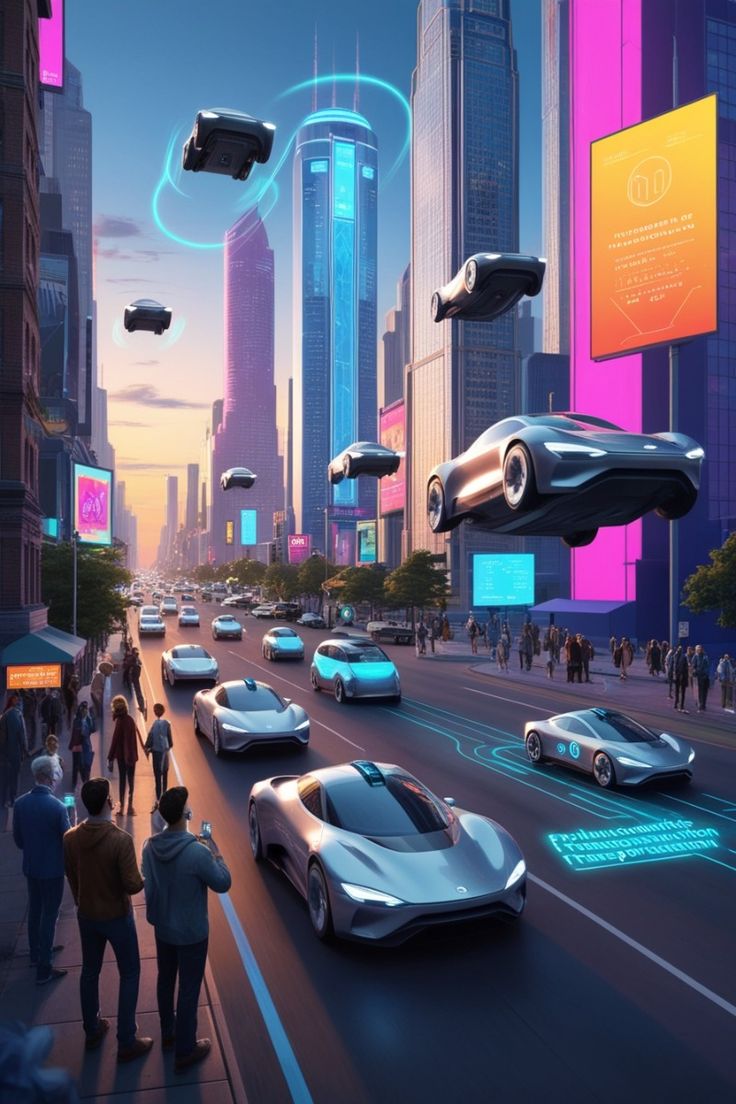Autonomous Vehicles: Revolutionizing Transportation in 2025
The future of transportation is arriving faster than ever, and autonomous vehicles (AVs) are at the forefront of this revolution. In 2025, we are witnessing unprecedented advances in self-driving car technology, with autonomous vehicles set to transform how we commute, travel, and even reshape the design of cities. These vehicles, equipped with sophisticated sensors, AI, and machine learning algorithms, have the potential to make roads safer, reduce traffic congestion, and promote sustainable travel.
In this article, we explore the key innovations in autonomous vehicles in 2025, the various benefits, and the challenges that come with this emerging technology.
What Are Autonomous Vehicles?
Autonomous vehicles, also known as self-driving cars, are vehicles that can operate without human intervention. They use a combination of technologies, including sensors (LIDAR, radar, and cameras), artificial intelligence (AI), machine learning, and GPS to navigate and make decisions in real-time. Autonomous vehicles are categorized into levels, from Level 0 (no automation) to Level 5 (full automation), as defined by the Society of Automotive Engineers (SAE). In 2025, we are progressing toward widespread implementation of Level 4 and Level 5 autonomous systems, where vehicles can operate independently in most conditions.
Key Innovations in Autonomous Vehicles (2025)
The journey toward fully autonomous transportation is progressing rapidly. In 2025, the technology powering these vehicles has advanced significantly, with the following innovations playing a major role:
1. Improved Sensor Technology
One of the cornerstones of autonomous vehicles is their ability to perceive and understand the environment around them. In 2025, sensors such as LIDAR (Light Detection and Ranging), radar, and cameras have become more precise, affordable, and integrated, enabling better detection of obstacles, pedestrians, and other vehicles. High-definition maps and real-time data processing allow vehicles to navigate through complex environments with greater accuracy, even in challenging weather conditions.
2. Advanced AI and Machine Learning
Artificial intelligence (AI) and machine learning are critical in enabling autonomous vehicles to make decisions and adapt to a dynamic environment. In 2025, AI algorithms are becoming more sophisticated, allowing vehicles to make split-second decisions on things like braking, acceleration, and lane changes. AI also helps with predictive analytics, allowing vehicles to anticipate the behavior of pedestrians, cyclists, and other drivers, making the roads safer for everyone.
3. V2X Communication (Vehicle-to-Everything)
V2X communication refers to the ability of autonomous vehicles to communicate with each other, as well as with infrastructure like traffic lights, road signs, and pedestrian signals. By 2025, vehicle-to-vehicle (V2V) and vehicle-to-infrastructure (V2I) communication systems are expected to become more widespread, allowing for more coordinated and efficient movement on the roads. This technology helps reduce traffic congestion, prevent accidents, and improve traffic flow by enabling real-time information sharing between vehicles and infrastructure.
4. Advanced Navigation and Mapping Systems
Accurate navigation and mapping are essential for autonomous vehicles to function smoothly. In 2025, the use of HD maps and real-time dynamic mapping technologies has improved the precision of vehicle positioning. Autonomous cars can now create highly detailed maps of their surroundings, helping them navigate even in complex, changing environments. As a result, self-driving cars can travel safely through cities, rural roads, and highways with minimal human supervision.
5. Enhanced Safety Systems
Safety is one of the biggest benefits of autonomous vehicles. In 2025, advancements in safety features include collision avoidance systems, automatic emergency braking, and adaptive cruise control that work seamlessly with AI and sensor technology. These systems are designed to anticipate potential hazards and take action before a collision occurs. With these capabilities, autonomous vehicles are expected to reduce traffic accidents, which are often caused by human error, such as distracted driving, fatigue, and impaired driving.
Benefits of Autonomous Vehicles
The widespread adoption of autonomous vehicles in 2025 brings numerous advantages, both for individuals and society as a whole:
1. Improved Road Safety
Human error is responsible for a significant percentage of traffic accidents, and autonomous vehicles are designed to eliminate this risk. By removing human error from the equation, autonomous cars are expected to dramatically reduce road accidents, fatalities, and injuries. The use of advanced sensors, AI, and real-time data processing ensures that self-driving cars can react faster and more accurately than human drivers.
2. Reduced Traffic Congestion
Autonomous vehicles have the potential to improve traffic flow and reduce congestion. By communicating with each other and traffic management systems, AVs can adjust their speed, lane changes, and routes to optimize traffic movement. This real-time coordination helps reduce the stop-and-go nature of traffic, leading to smoother and more efficient commutes.
3. Increased Mobility for All
Autonomous vehicles can provide greater mobility options for individuals who are unable to drive due to age, disability, or other reasons. In 2025, we expect that self-driving cars will become more accessible, offering people with limited mobility the ability to travel independently. This could significantly improve the quality of life for seniors, people with disabilities, and those who rely on public transportation.
4. Environmental Benefits
Autonomous vehicles could contribute to reducing carbon emissions and improving environmental sustainability. AVs are likely to be electric, which would help reduce the carbon footprint associated with traditional gasoline-powered cars. Moreover, self-driving vehicles can optimize driving patterns, such as acceleration and braking, leading to more fuel-efficient driving and reduced overall emissions. In combination with shared mobility, the widespread adoption of AVs could also reduce the number of vehicles on the road, further decreasing pollution levels.
5. Reduced Transportation Costs
While the initial cost of purchasing an autonomous vehicle may be high, long-term savings are expected due to lower insurance premiums, reduced accident-related expenses, and optimized fuel efficiency. Furthermore, autonomous vehicles could lead to more efficient car-sharing services, reducing the need for individuals to own their own vehicles. This could lower overall transportation costs for consumers.
Challenges and Concerns
Despite the exciting potential of autonomous vehicles, several challenges remain in the path to widespread adoption. These include:
1. Regulatory and Legal Hurdles
In 2025, the legal and regulatory landscape surrounding autonomous vehicles is still evolving. Governments and regulatory bodies must create new laws and regulations that address issues such as liability in the event of an accident, data privacy concerns related to the use of vehicle data, and the certification of self-driving technology. The absence of standardized rules across regions may slow down the integration of autonomous vehicles into existing infrastructure.
2. Ethical Considerations
Autonomous vehicles rely on AI to make decisions, and this raises complex ethical dilemmas. For example, how should an autonomous vehicle respond in an unavoidable crash scenario where it must choose between two harmful outcomes? How should it prioritize the safety of its passengers versus pedestrians or other road users? These ethical concerns must be addressed before self-driving vehicles can be fully integrated into society.
3. Cybersecurity Risks
As autonomous vehicles become more connected, they also become more vulnerable to cyberattacks. Hackers could potentially interfere with the vehicle’s control systems, causing accidents or even using the vehicle for malicious purposes. In 2025, cybersecurity measures must be robust enough to protect AVs from such threats, ensuring the safety of passengers and other road users.
4. Public Perception and Trust
While autonomous vehicles offer many benefits, public trust in the technology remains a key challenge. High-profile accidents involving self-driving cars have raised concerns about their reliability and safety. In 2025, educating the public about the safety features and capabilities of autonomous vehicles, as well as gaining their trust, will be critical to ensuring the widespread adoption of AVs.
The Future of Autonomous Vehicles in 2025 and Beyond
In 2025, autonomous vehicles are not just a futuristic concept; they are beginning to integrate into the fabric of daily transportation. With advancements in sensor technology, AI, and connectivity, self-driving cars are becoming more capable, reliable, and safer. However, overcoming regulatory, ethical, and public perception challenges will be essential for the full realization of the potential of autonomous vehicles.
As we move toward a future of self-driving cars, the benefits in terms of safety, efficiency, and accessibility will outweigh the challenges, making autonomous vehicles a critical part of the future of transportation. The road ahead is full of opportunities for innovation, and 2025 will mark a significant milestone in the journey toward fully autonomous and smarter transportation systems.










